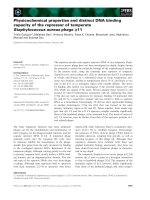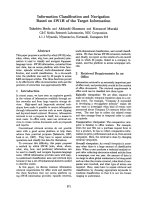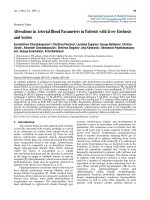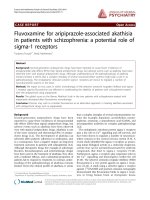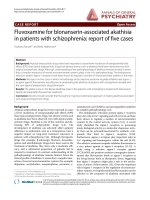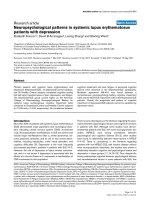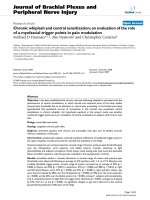Báo cáo y học: "Weekly self-monitoring and treatment adjustment benefit patients with partly controlled and uncontrolled asthma: an analysis of the SMASHING study" pps
Bạn đang xem bản rút gọn của tài liệu. Xem và tải ngay bản đầy đủ của tài liệu tại đây (612.58 KB, 9 trang )
van der Meer et al. Respiratory Research 2010, 11:74
/>Open Access
RESEARCH
© 2010 van der Meer et al; licensee BioMed Central Ltd. This is an Open Access article distributed under the terms of the Creative Com-
mons Attribution License ( which permits unrestricted use, distribution, and reproduc-
tion in any medium, provided the original work is properly cited.
Research
Weekly self-monitoring and treatment adjustment
benefit patients with partly controlled and
uncontrolled asthma: an analysis of the SMASHING
study
Victor van der Meer*
1,2
, Henk F van Stel
1
, MoiraJBakker
1
, Albert C Roldaan
3
, Willem JJ Assendelft
2
, Peter J Sterk
4
,
Klaus F Rabe
5
, Jacob K Sont
1,5
for the SMASHING (Self-Management of Asthma Supported by Hospitals, ICT, Nurses
and General practitioners) Study Group
Abstract
Background: Internet-based self-management has shown to improve asthma control and asthma related quality of
life, but the improvements were only marginally clinically relevant for the group as a whole. We hypothesized that self-
management guided by weekly monitoring of asthma control tailors pharmacological therapy to individual needs and
improves asthma control for patients with partly controlled or uncontrolled asthma.
Methods: In a 1-year randomised controlled trial involving 200 adults (18-50 years) with mild to moderate persistent
asthma we evaluated the adherence with weekly monitoring and effect on asthma control and pharmacological
treatment of a self-management algorithm based on the Asthma Control Questionnaire (ACQ). Participants were
assigned either to the Internet group (n = 101) that monitored asthma control weekly with the ACQ on the Internet
and adjusted treatment using a self-management algorithm supervised by an asthma nurse specialist or to the usual
care group (UC) (n = 99). We analysed 3 subgroups: patients with well controlled (ACQ ≤ 0.75), partly controlled
(0.75>ACQ ≤ 1.5) or uncontrolled (ACQ>1.5) asthma at baseline.
Results: Overall monitoring adherence was 67% (95% CI, 60% to 74%). Improvements in ACQ score after 12 months
were -0.14 (p = 0.23), -0.52 (p < 0.001) and -0.82 (p < 0.001) in the Internet group compared to usual care for patients
with well, partly and uncontrolled asthma at baseline, respectively. Daily inhaled corticosteroid dose significantly
increased in the Internet group compared to usual care in the first 3 months in patients with uncontrolled asthma
(+278 μg, p = 0.001), but not in patients with well or partly controlled asthma. After one year there were no differences
in daily inhaled corticosteroid use or long-acting β
2
-agonists between the Internet group and usual care.
Conclusions: Weekly self-monitoring and subsequent treatment adjustment leads to improved asthma control in
patients with partly and uncontrolled asthma at baseline and tailors asthma medication to individual patients' needs.
Trial registration: Current Controlled Trials ISRCTN79864465
Background
Recent international guidelines define asthma control in
terms of two domains: impairment and risk [1,2]. The
distinction between these two domains for assessing
asthma control emphasizes the need to consider sepa-
rately patients' functional capacity on an ongoing basis in
the present and the risks for adverse events, such as side
effects of medication, progressive lung function loss or
exacerbations in the future.
Ongoing monitoring of asthma control (both impair-
ment and risk) is required to determine whether the goals
of therapy are met [1,3]. Well-validated self-assessment
questionnaires are available to periodically monitor the
* Correspondence:
1
Dept of Medical Decision Making, Leiden University Medical Center, Leiden,
T
he Netherlands
Full list of author information is available at the end of the article
van der Meer et al. Respiratory Research 2010, 11:74
/>Page 2 of 9
level of asthma control [4-6]. Each of these instruments
assesses the impairment domain by measuring asthma
symptoms, limitation of activities and need for rescue
medication. However, lung function is only included in
the Asthma Control Questionnaire (ACQ) [4]. The peri-
odic assessment of lung function is important, since it
captures both asthma impairment at present and may
detect future risk of progressive lung function and exac-
erbations [7,8].
The frequency of periodic monitoring depends on the
phase of treatment [9]. At the initial phase intensive mon-
itoring is required to evaluate the effect of treatment
titration in order to achieve better asthma control. Once
control has been achieved, the monitoring interval may
be longer [9]. Monitoring frequency and subsequent
treatment decisions therefore depend on the level of
asthma control and vice versa.
We have conducted a trial in which the ACQ was used
as a weekly monitoring tool and participants made treat-
ment decisions according to an ACQ-based algorithm
[10]. Asthma control and asthma related quality of life
improved compared to usual physician-guided care, but
the improvements were only marginally clinically rele-
vant for the group as a whole [10]. In the present pre-
planned analysis we investigated whether a simple index
of asthma control can be used to predict the outcomes of
Internet-based self-management. We hypothesized that
self-management guided by weekly monitoring of asthma
control tailors pharmacological therapy to individual
needs and improves asthma control for patients with
partly controlled or uncontrolled asthma.
Methods
Patients
Full details of the study methodology and subjects for the
Self-Management of Asthma Supported by Hospitals,
ICT, Nurses and General Practitioners (SMASHING)
project at baseline have previously been published [10].
Briefly, the study enrolled 200 adults with asthma who
were recruited from 37 general practices (69 general
practitioners) in and around Leiden, The Netherlands,
and from the outpatient department of Pulmonology of
the Leiden University Medical Center. We included
patients with physician diagnosed asthma, aged between
18 and 50 years who had a prescription of inhaled corti-
costeroids for at least three months in the previous year.
We excluded patients on continuous oral glucocorticos-
teroid and patients on omalizumab. The study was
approved by the Medical Ethics Committee of the Leiden
University Medical Center. All participants gave written
informed consent.
Design
This analysis is part of a prospective, randomised con-
trolled cost-effectiveness trial (ISRCTN79864465) [10].
Participants collected baseline data during a period of 2
weeks. They were trained to measure forced expiratory
volume in 1 second (FEV
1
) daily with a hand-held elec-
tronic spirometer (PiKo1; Ferraris, UK) and were asked to
report the highest value of three measurements in the
morning on a designated Web application or by mobile
phone text messaging. Along with the FEV
1
value partici-
pants reported night time and daytime symptom scores.
All participants were asked to complete the Asthma Con-
trol Questionnaire (ACQ) weekly on the Web application.
During the baseline period participants received no feed-
back on lung function or clinical status.
After the baseline period, patients were randomised to
either Internet-based self-management (Internet group)
or usual physician-provided care (usual care group). The
Internet group was instructed to use a personal Internet-
based asthma action plan. This action plan required
weekly completion of the ACQ via the Internet for a
period of 1 year. After reporting the ACQ, participants
instantly received a return message on the Website
including advice on how to adjust treatment and a graph-
ical representation of lung function and ACQ over time.
Patients in the usual care group did not use the ACQ
throughout the study and did not receive weekly treat-
ment advice. They received asthma care according to the
Dutch general practice guidelines on adult asthma man-
agement, which recommend follow-up consultations
every 2-4 weeks if asthma is not well controlled and med-
ical review every year in well controlled asthma [11].
These national guidelines are based on international rec-
ommendations such as the GINA guidelines for asthma
management and prevention [3].
After 3 months and after 1 year both the Internet and
the usual care group collected asthma control data for a
period of 2 weeks similar to the baseline period.
Asthma Control Questionnaire
The ACQ is a 7-item questionnaire that has been vali-
dated to measure asthma control [4]. The items refer to
asthma symptoms, rescue bronchodilator use and FEV
1
%
of predicted normal. Responses are given on a 7-point
scale and the overall score is the mean of the responses
where 0 = totally controlled and 6 = severely uncon-
trolled.
Asthma Therapy Assessment Questionnaire - control index
The ATAQ is a 20-item questionnaire that generates indi-
cators of problems in asthma care. The control index of
the ATAQ contains 4 items that refer to asthma symp-
toms, activity limitation and rescue bronchodilator use in
the past 4 weeks. Sum scores range from 0 (no control
problems) to 4 (control problems) [1,5].
Treatment algorithm
Five pulmonologists, two general practitioners with spe-
cial interest in respiratory disease and two respiratory
epidemiologists participated in the development of the
van der Meer et al. Respiratory Research 2010, 11:74
/>Page 3 of 9
algorithm for the Internet-based asthma action plan. This
algorithm was based on consecutive weekly ACQ scores.
Two previous studies identified cut-off points for levels of
asthma control. Juniper et al reported a cut-point of 0.75
for patients with well controlled asthma and a cut-point
of 1.50 for patients with uncontrolled asthma [12]. Van
den Nieuwenhof et al described cut-off points of 0.5, 1.0
and 1.5 to differentiate between the four severity levels of
asthma in accordance with the GINA guidelines,
although omitting the FEV
1
% of predicted normal [13].
Based on a clinically important difference of 0.5 the
algorithm in our study uses three cut-points with 0.5
points differences: 0.5, 1.0 and 1.5 including the FEV
1
% of
predicted normal [14]. It provides instructions to
increase treatment (step-up) or decrease treatment (step-
down) according to a pre-defined action plan. Figure 1
and table 1 show the treatment algorithm and action plan
respectively. In brief, treatment step-up is advised when
the ACQ score is above 1.0 once or between 0.5 and 1.0
twice consecutively and treatment step-down is advised
after four weeks of ACQ scores below 0.5. When the
ACQ score is above 1.5 the algorithm additionally advises
to contact the asthma nurse or other health care provider.
An evaluation period of four weeks without treatment
changes follows after step-up instruction. Step-down
instruction is followed by a period of four weeks (step-
down period) in which no second step-down can be
advised, but in case of deteriorating asthma, a treatment
step-up is possible in this period.
Monitoring adherence
Monitoring adherence was defined as the proportion of
weekly completed Internet-based ACQs in the Internet
group in each month of follow-up. We analyzed three
subgroups of patients to allow evaluation of adherence
for different levels of asthma control at baseline: well con-
trolled (ACQ < 0.75), partly controlled (ACQ ≥ 0.75 to <
1.5) or uncontrolled asthma (ACQ ≥ 1.5) [1,12].
Outcome measures
Asthma control was the primary process outcome.
Asthma control was calculated as the average of ACQ
scores during the two-week baseline and two-week end
periods. The ATAQ control index measures the same
Figure 1 Algorithm based on consecutive ACQ scores to adjust medical treatment [10]. * At entry the evaluation period is bypassed.
No medication
change
ACQ
previous
ACQ
today
Step down Step up
All ACQs in
optimal control
period 0.5
Evaluation period
> 28 days
Optimal control
period > 28 days
No medication
change
Reset optimal
control period
Reset evaluation
period
0.5 – 1.0
0.5 – 1.0 0.5
0.5
1.0 – 1.5
Yes
No
Yes
No
No
Yes
1.5
Immediate
step up
Immediate step up
+ contact asthma nurse
START
Evaluation period *
starts after treatment step up
Optimal control period
starts after one ACQ 0.5
van der Meer et al. Respiratory Research 2010, 11:74
/>Page 4 of 9
construct as the ACQ (i.e. asthma control) and therefore
acted as a measure of construct validity in order to sup-
port changes in ACQ.
Secondary outcome measures were the mean daily dose
of inhaled corticosteroid (ICS), and the proportion of
participants using long-acting β
2
-agonists (LABA) or leu-
kotriene receptor antagonists (LTRA). Inhaled corticos-
teroid doses were reported as fluticasone equivalents.
Data on pharmacological treatment were obtained from
self-reports at baseline and after 3 months and 1 year.
We analyzed three subgroups of patients to allow evalu-
ation of the treatment algorithm for different levels of
asthma control at baseline: well controlled (ACQ < 0.75),
partly controlled (ACQ ≥ 0.75 to < 1.5) or uncontrolled
asthma (ACQ ≥ 1.5) [3,12].
Sample size
With the 100 participants per study group and a standard
deviation of changes in ACQ score of 0.69 we were able to
detect at least a 0.28 difference between ACQ score
changes in the two study groups (significance level 0.05
two-sided; power 0.80 one-sided) [15]. A clinically impor-
tant decrease in ACQ score of at least 0.50 could thus be
detected if at least 30 participants were present per sub-
group [14].
Statistical analysis
Differences in ACQ scores and inhaled corticosteroid
doses between Internet and UC groups at two time points
(3 and 12 months) were analyzed using multivariate lin-
ear regression modelling with a random intercept to
adjust for repeated measures [16]. The construct validity
of the ACQ as an outcome measure was evaluated by
Pearson's correlation coefficients: 1) between ACQ and
ATAQ control index at baseline and 12 months and 2)
between change scores (12 months minus baseline value)
of ACQ and ATAQ control index.
Differences in the proportion of patients using long-
acting β
2
-agonists or leukotriene receptor antagonists
between the two groups and at the two different time
point were analyzed using multivariate population aver-
aged logistic regression analysis with a random intercept
[16]. Covariates in both regression models were baseline
values of the appropriate outcome parameter, sex, age,
education level, smoking status and type of care provider.
All analyses were carried out on an intention-to-treat
basis. We used the statistical software package STATA 9.0
(StataCorp; College Station TX, US).
Results
Figure 2 summarizes the participant flow during enrol-
ment, allocation and follow-up [figure 2]. A total of 200
consented to participate in the randomised controlled
study: 75 patients had well controlled asthma, 71 had
partly controlled asthma and 54 had uncontrolled asthma
at baseline [table 2]. Mean age was 36.3 and 31% were
males. Smoking was reported more often in patients with
uncontrolled asthma (33% current smokers) than in
patients with partly controlled (8%) or well controlled
asthma (3%). The ACQ at baseline was 0.43, 1.10 and 2.09
for the three groups, respectively. Inhaled corticosteroid
use at baseline was 448, 483 and 620 μg/day, respectively.
The use of long-acting β
2
-agonists was similar for the
groups with partly and uncontrolled asthma (62% and
63%), and only slightly higher than in patients with well
controlled asthma (55% long-acting β
2
-agonists use). Five
patients used leukotriene receptor antagonists: one in the
group with well controlled asthma, two in the group with
partly controlled asthma and two in the groups with
uncontrolled asthma.
Monitoring adherence
Overall monitoring adherence was 67% (95% CI, 60 to
74%). Adherence to ACQ monitoring gradually declined
from the first month (88%) to the seventh month (60%)
and then remained stable up to 1 year. Monitoring in the
three subgroups was 71%, 68% and 58% during the one-
year follow-up for well, partly and uncontrolled asthma at
baseline, respectively [figure 3].
Asthma control
There were no deviations from random allocation. ACQ
scores at 12 months were provided by 69 (92%), 69 (97%)
Table 1: Treatment steps for the Internet-based asthma
action plan
Step* Medication
1 As needed rapid-acting β
2
-agonist†
2 Low-dose inhaled glucocorticosteroids
3a Low-dose inhaled glucocorticosteroids plus long-
acting β
2
-agonist
3b Medium-dose inhaled glucocorticosteroids
3c High-dose inhaled glucocorticosteroids
4a Medium-dose inhaled glucocorticosteroids plus
long-acting β
2
-agonist
4b High-dose inhaled glucocorticosteroids plus long-
acting β
2
-agonist
4c Contact asthma nurse‡: consider addition of
leukotriene modifier
5Contact asthma nurse‡: consider addition of oral
glucocorticosteroid
* Step numbers correspond with recommended steps in GINA
guidelines figure 4.3-2. [3]
† Applies to all treatment steps
‡ Or other health care provider
van der Meer et al. Respiratory Research 2010, 11:74
/>Page 5 of 9
and 44 (81%) participants with well, partly and poorly
controlled asthma, respectively.
Figure 4 shows the ACQ scores at baseline, 3 and 12
months of follow-up in the UC and Internet group for
each baseline control level [figure 4]. In patients with well
controlled asthma at baseline ACQ scores were not sig-
nificantly different between the usual care and Internet
group during follow-up. In patients with partly controlled
asthma at baseline ACQ scores in the Internet group
improved with -0.44 (95% CI, -0.67 to -0.22) and -0.51 (-
0.73 to -0.29) after 3 and 12 months, respectively, com-
pared to usual care. In patients with uncontrolled asthma
at baseline ACQ scores in the Internet group improved
with -0.57 (95% CI, -0.84 to -0.31) and -0.82 (-1.10 to -
0.55) after 3 and 12 months, respectively, compared to
usual care. Correlations between ACQ and ATAQ control
index were 0.57 (p < 0.001) and 0.64 (p < 0.001) at base-
line and 12 months, respectively. The correlation of
change scores was 0.52 (p < 0.001).
Pharmacological therapy
Figure 5 shows the daily dose of inhaled corticosteroid
(ICS) at baseline, 3 and 12 months of follow-up in the
usual care and Internet group for each baseline control
level [figure 5]. In patients with well controlled asthma at
baseline the ICS dose increased non-significantly, fol-
lowed by a significant decrease from 3 to 12 months (p =
0.042). At 12 months the ICS dose was similar for both
groups: difference -9 μg (95% CI, -147 to 130). In patients
with partly controlled asthma at baseline the ICS dose
increased in the first 3 months and decreased in the next
9 months in the Internet compared to the usual care
group, both changes being non-significant. At 12 months
the ICS dose did not differ between the groups: difference
54 μg (95% CI, -86 to 194). Patients with uncontrolled
asthma showed a significant increase in the first 3 months
(278 μg, p = 0.001) followed by a significant decrease in
the next 9 months (-149 μg, p = 0.043) in the Internet
group compared to usual care. At 12 months the ICS dose
was not significantly higher in the Internet group com-
pared to usual care: difference 130 μg (95% CI, -43 to
303).
The number of patients using LABA or LTRA was not
significantly different between the three baseline control
levels and are therefore presented altogether. The propor-
tion of patients using LABA was similar for the Internet
and usual care group at 3 months (63% Internet and 62%
usual care; p = 0.60) and 12 months (64% Internet and
58% usual care, p = 0.11), adjusted OR: 1.61 (95% CI, 0.74
to 3.48).
Figure 2 Flow diagram of subject progress through the study.
eligible patients
n=200
recruited from 37 general
practices and 1 out-patient
department
Internet group
n=101
Usual care group
n=99
3
months
12
months
baseline
well
controlled
n=38
partly
controlled
n=33
uncontrolled
n=28
completed
ACQ
n=38
completed
ACQ
n=21
completed
ACQ
n=33
well
controlled
n=37
partly
controlled
n=38
uncontrolled
n=26
completed
ACQ
n=36
completed
ACQ
n=25
completed
ACQ
n=35
completed
ACQ
n=33
completed
ACQ
n=21
completed
ACQ
n=38
completed
ACQ
n=36
completed
ACQ
n=23
completed
ACQ
n=31
van der Meer et al. Respiratory Research 2010, 11:74
/>Page 6 of 9
Only a few patients used LTRA. The proportion of
patients using LTRA was significantly higher for the
Internet group than usual care at 3 months (9% vs 2%,
adjusted OR: 6.03 (95% CI, 1.03 to 35.4)), but not at 12
months (10% vs 4%, adjusted OR: 2.63 (95% CI, 0.67 to
10.3)).
Discussion
This analysis provides insight into the effects of internet-
based self-management guided by an electronic algo-
rithm based on weekly assessment of asthma impairment
on process outcomes for three different levels of asthma
control at baseline. Adherence to the Internet-based
monitoring instrument was 67%. The results show a con-
siderable improvement in asthma control for patients
with partly controlled or uncontrolled asthma at baseline
without significant increases in inhaled corticosteroids,
long-acting β
2
-agonists or leukotriene receptor antago-
nist use at 12 months.
This is the first randomised controlled evaluation of
asthma self-management guided by a short validated
questionnaire on asthma control. The current dynamic
asthma management strategy reflects the varying and
intermittent course of the disease, rather than doctor vis-
its every three months as mentioned in international
guidelines as they stand [1,3]. Our analysis reveals three
important findings regarding asthma control, pharmaco-
logical therapy and monitoring adherence in the three
subgroups of patients with different levels of asthma con-
trol at baseline.
First, the improvements in asthma control scores for
patients with partly or uncontrolled asthma at baseline
Table 2: Baseline characteristics of 200 patients with mild to moderate persistent asthma who were randomised to
Internet group or usual care group
Well controlled
asthma
Partly controlled
asthma
Uncontrolled asthma
Usual
Care
group
(n = 38)
Internet
group
(n = 37)
Usual
Care
group
(n = 33)
Internet
group
(n = 38)
Usual
Care
group
(n = 28)
Internet
group
(n = 26)
Age, mean yr (SD) 37.6 (7.5) 35.8 (8.9) 36.3 (10.1) 35.5 (9.7) 36.0 (6.9) 36.9 (7.6)
Male, no. (%) 12 (31.6) 11 (29.7) 10 (30.3) 8 (21.1) 7 (25.0) 13 (50.0)
Lower education, no. (%) 4 (10.5) 2 (5.4) 2 (6.1) 4 (10.5) 8 (28.6) 5 (19.2)
Current smoker, no. (%) 1 (2.6) 1 (2.7) 4 (12.1) 2 (5.3) 9 (32.1) 9 (34.6)
Subspecialty care, no. (%) 6 (15.8) 6 (16.2) 6 (18.2) 11 (29.0) 8 (28.6) 4 (15.4)
Duration of asthma, mean yr (SD) 16.8
(11.4)
15.5
(14.0)
20.4 (13.3) 16.1
(12.6)
15.8 (14.5) 14.2 (9.9)
Pre-bronchodilator FEV
1
(% pred), mean (SD) 96.1
(11.4)
102.3
(13.4)
89.6 (13.6) 86.5 (9.6) 83.2 (14.9) 70.9 (15.9)
ACQ, mean (SD) 0.40
(0.23)
0.46
(0.18)
1.08 (0.22) 1.12
(0.23)
2.11 (0.55) 2.07 (0.44)
ATAQ control index, median (range) 1 (0-3) 1 (0-3) 1 (0-3) 1 (0-3) 2 (0-3) 2.5 (0-4)
Inhaled corticosteroids, mean μg/day (SD) 480 (368) 416
(236)
475 (377) 489 (309) 618 (311) 623 (316)
Long-acting β2-agonist, no. (%) 23 (60.5) 18 (48.7) 17 (51.5) 27 (71.1) 19 (67.9) 15 (57.7)
Leukotriene modifier, no. (%) 0 (0) 1 (2.7) 0 (0) 2 (5.3) 2 (7.1) 0 (0)
Figure 3 Monitoring adherence (percentages) for patients with
well controlled (n = 75), partly controlled (n = 71) or uncontrolled
asthma at baseline (n = 54).
20 40 60
80 100
Monitoring adherence (%)
0 3 6 9 12
Month of follow-up
Well controlled asthma
Partly controlled asthma
Uncontrolled asthma
van der Meer et al. Respiratory Research 2010, 11:74
/>Page 7 of 9
Figure 4 ACQ scores during study follow-up for patients with well controlled (panel I; n = 75), partly controlled (panel II; n = 71) or uncon-
trolled asthma at baseline (panel III; n = 54). P-values represent statistical significance of change scores between Internet group and usual care.
Error bars indicate the standard error of the mean.
0
0.5
1 1.5 2
0 3 6 9 12
Month of follow-up
Usual care group
Internet group
0 3 6 9 12
Month of follow-up
0 3 6 9 12
Month of follow-up
Asthma Control Questionnaire
P=0.08
P=0.61
P=0.23
P<0.001
P=0.54
P<0.001
P<0.001 P=0.07
P<0.001
Well controlled asthma at baseline Partly controlled asthma at baseline Uncontrolled asthma at baseline
0
0.5
1 1.5 2
0 3 6 9 12
Month of follow-up
Usual care group
Internet group
0 3 6 9 12
Month of follow-up
0 3 6 9 12
Month of follow-up
Asthma Control Questionnaire
P=0.08
P=0.61
P=0.23
P<0.001
P=0.54
P<0.001
P<0.001 P=0.07
P<0.001
Well controlled asthma at baseline Partly controlled asthma at baseline Uncontrolled asthma at baseline
Figure 5 Mean daily dose of inhaled corticosteroids (μg) during study follow-up for patients with well controlled (panel I; n = 75), partly
controlled (panel II; n = 71) or uncontrolled asthma at baseline (panel III; n = 54). P-values represent statistical significance of change scores
between Internet group and usual care. Error bars indicate the standard error of the mean.
300 400 500 600 700 800
0 3 6 9 12
Month of follow-up
Usual care group
Internet group
0 3 6 9 12
Month of follow-up
0 3 6 9 12
Month of follow-up
P=0.10
P=0.04
P=0.90
P=0.08
P=0.23
P=0.45
P=0.001 P=0.04
P=0.14
Daily inhaled corticosteroid dose (μg)
Well controlled asthma at baseline Partly controlled asthma at baseline Uncontrolled asthma
at baseline
300 400 500 600 700 800
0 3 6 9 12
Month of follow-up
Usual care group
Internet group
0 3 6 9 12
Month of follow-up
0 3 6 9 12
Month of follow-up
P=0.10
P=0.04
P=0.90
P=0.08
P=0.23
P=0.45
P=0.001 P=0.04
P=0.14
Daily inhaled corticosteroid dose (μg)
Well controlled asthma at baseline Partly controlled asthma at baseline Uncontrolled asthma
at baseline
van der Meer et al. Respiratory Research 2010, 11:74
/>Page 8 of 9
suggest a significant reduction of current asthma symp-
toms. Remarkably, control scores stabilised or even con-
tinued to improve after 3 months, while ICS doses
decreased in patients with well or uncontrolled asthma at
baseline. A possible explanation is that to achieve asthma
control higher doses of anti-inflammatory therapy are
needed than to maintain asthma control [3]. The reduced
need for ICS may decrease future risk for side effects of
medication.
Second, this asthma action plan is one of few that not
only specifies action points to increase, but also to
decrease treatment, which provides the possibility to tai-
lor medication to individual needs. All three baseline
control level groups showed a similar pattern of pharma-
cological therapy over time: an increase in inhaled corti-
costeroids in the first three months, followed by a
decrease in the next 9 months. It can be seen that only for
patients with uncontrolled asthma at baseline the inhaled
corticosteroid dose significantly increased after three
months. With regard to long-acting β
2
-agonists, the slight
numeric difference of 6% in prescription can only partly
explain the difference in findings in asthma control, since
the magnitude of the improvements in asthma control
suggests that the majority of the 59 patients with partly
controlled or uncontrolled asthma experienced a clini-
cally relevant improvement. Therefore, the patterns of
increases and decreases in inhaled corticosteroids and
long-acting β
2
-agonists reflected tailoring of medication
to individual patients' needs rather than a mere increase
of medication for the whole population.
Third, this study showed that weekly Internet-based
monitoring is feasible in terms of monitoring adherence.
In the groups with well and partly controlled asthma at
baseline monitoring adherence of about 80% in the first 3
months decreased to 60% during the last months of fol-
low-up. Despite declining monitoring adherence, asthma
remained adequately controlled. This reflects the reduced
need for monitoring once control of the disease has been
achieved [9]. Patients with uncontrolled asthma at base-
line monitored asthma control in 80% during the first 3
months (similar to patients with well and partly con-
trolled asthma). However, In this group monitoring
adherence declined to below 50% and asthma control did
not reach the good control scores (below 0.75) as it did in
the well and partly controlled groups. Efforts to optimise
monitoring adherence may further increase asthma con-
trol.
Three methodological issues are of particular interest.
The outcomes of our study were patient reported. Patient
reported outcomes may have a risk of reduced validity
compared to objective outcomes. Since the ACQ was
both the target of the intervention and the main outcome
measure, there was the possibility of a circular argument:
a decrease in ACQ might have indicated that the algo-
rithm worked, but not necessarily that asthma control
improved. Therefore we used the ATAQ as a construct
validity instrument and calculated correlations between
ACQ and ATAQ. The moderate to good correlations,
both cross-sectional and longitudinal, not only illustrated
the effectiveness of a potent algorithm, but also sup-
ported our conclusion that indeed asthma control
improved. With regard to medication reports, we asked
patients to bring their inhalers at baseline and end visits,
which enhanced the validity. However, patients may have
reported different numbers of puffs than actually used or
other types of inhalers than they actually brought to the
visits.
Second, we recognize that the effect of the Internet-
based self-management intervention can not solely be
attributed to our treatment algorithm. We emphasize
that, except for asthma monitoring and a medical treat-
ment plan, a self-management asthma support pro-
gramme should consist of asthma education,
environmental control and medical review [17].
Third, our trial had a highly pragmatic attitude [18]. It
was conducted in normal practice rather than an ideal
research setting. Exclusion criteria were limited and the
intervention was applied flexibly, i.e. patients' adherence
to the monitoring and treatment algorithm was not
strictly enforced, but patients and health care providers
were allowed to make their own choices regarding moni-
toring and treatment as it would be in normal practice.
The choice of this pragmatic design enhances applicabil-
ity of the results in the real life.
Conclusions
To conclude, weekly self-monitoring and subsequent
treatment adjustment leads to improved asthma control
in patients with partly and uncontrolled asthma at base-
line and tailors asthma medication to individual patients'
needs. Future asthma treatment strategies should incor-
porate continuous self-monitoring with use of a short val-
idated questionnaire on asthma control.
Competing interests
VM, HFS, MJB, ACR, WJJA, PJS, KFR and JKS have no declared conflict of interest.
Authors' contributions
VM contributed to conception and design, acquisition of data and analysis and
interpretation of data and drafted the manuscript. HFS contributed to analysis
and interpretation of data and critically revised the manuscript. MJB contrib-
uted to acquisition of data and critically revised the manuscript. ACR contrib-
uted to analysis and interpretation of data and critically revised the manuscript.
WJJA contributed to acquisition of data, analysis and interpretation of data and
critically revised the manuscript. PJS contributed to conception and design,
interpretation of data and critically revised the manuscript. KFR contributed to
analysis and interpretation of data and critically revised the manuscript. JKS
contributed to conception and design, acquisition of data and analysis and
interpretation of data and critically revised the manuscript. All authors read and
approved the final manuscript.
Acknowledgements
The SMASHING (Self-Management of Asthma Supported by Hospitals, ICT,
Nurses and General practitioners) Study Group: WJJ Assendelft, MD, PhD; MJ
Bakker, RN; EH Bel, MD, PhD; SB Detmar PhD; JC de Jongste, MD, PhD; AA
Kaptein, PhD; V van der Meer, MD; W Otten, PhD; KF Rabe, MD, PhD; ERVM Rik-
kers-Mutsaerts, MD; AC Roldaan, MD, PhD; JK Sont, PhD; HF van Stel, PhD; PJ
Sterk, PhD; HA Thiadens, MD, PhD; PJ Toussaint, PhD. We thank professor EF
van der Meer et al. Respiratory Research 2010, 11:74
/>Page 9 of 9
Juniper for the permission to use a web-based version of the Asthma Control
Questionnaire.
Author Details
1
Dept of Medical Decision Making, Leiden University Medical Center, Leiden,
The Netherlands,
2
Dept of Public Health and Primary Care, Leiden University
Medical Center, Leiden, The Netherlands,
3
Dept of Pulmonology, HAGA
Hospital, The Hague, The Netherlands,
4
Dept of Respiratory Medicine,
Academic Medical Center, University of Amsterdam, Amsterdam, The
Netherlands and
5
Dept of Pulmonology, Leiden University Medical Center,
Leiden, The Netherlands
References
1. National Heart Lung and Blood Institute. National Asthma Education and
Prevention Program(NAEPP): Expert panel report 3: Guidelines for the
Diagnosis and Management of Asthma. 2007.
2. Taylor DR, Bateman ED, Boulet L-P, Boushey HA, Busse WW, Casale TB,
Chanez P, Enright PL, Gibson PG, de Jongste JC, Kerstjens HA, Lazarus SC,
Levy ML, O'Byrne PM, Partridge MR, Pavord ID, Sears MR, Sterk PJ, Stoloff
SW, Szefler SJ, Sullivan SD, Thomas MD, Wenzel SE, Reddel HK: A new
perspective on concepts of asthma severity and control. Eur Respir J
2008, 32:545-554.
3. National Institutes of Health. Global initiative for asthma: Global strategy
for asthma management and prevention. NIH Publication No 02-3659.
Issued January 1995 (Updated 2006)
4. Juniper EF, O'Byrne PM, Guyatt GH, Ferrie PJ, King DR: Development and
validation of a questionnaire to measure asthma control. Eur Respir J
1999, 14:902-907.
5. Vollmer WM, Markson LE, O'Connor E, Frazier EA, Berger M, Buist AS:
Association of asthma control with health care utilization and quality
of life. Am J Respir Crit Care Med 1999, 160:1647-652.
6. Nathan RA, Sorkness CA, Kosinski M, Schatz M, Li JT, Marcus P, Murray JJ,
Pendergraft TB: Development of the asthma control test: a survey for
assessing asthma control. J Allergy Clin Immunol 2004, 113:59-65.
7. Reddel HK, Taylor DR, Bateman ED, Boulet LP, Boushey HA, Busse WW,
Casale TB, Chanez P, Enright PL, Gibson PG, de Jongste JC, Kerstjens HA,
Lazarus SC, Levy ML, O'Byrne PM, Partridge MR, Pavord ID, Sears MR, Sterk
PJ, Stoloff SW, Sullivan SD, Szefler SJ, Thomas MD, Wenzel SE, American
Thoracic Society/European Respiratory Society Task Force on Asthma
Control and Exacerbations: An official American Thoracic Society/
European Respiratory Society statement: asthma control and
exacerbations: standardizing endpoints for clinical asthma trials and
clinical practice. Am J Respir Crit Care Med 2009, 180:59-99.
8. Fuhlbrigge AL, Kitch BT, Paltiel AD, Kuntz KM, Neumann PJ, Dockery DW,
Weiss ST: FEV(1) is associated with risk of asthma attacks in a pediatric
population. J Allergy Clin Immunol 2001, 107:61-67.
9. Glasziou P, Irwig L, Mant D: Monitoring in chronic disease: a rational
approach. BMJ 2005, 330:644-648.
10. Van der Meer V, Bakker MJ, Van den Hout WB, Rabe KF, Sterk PJ, Kievit J,
Assendelft WJ, Sont JK, SMASHING (Self-Management in Asthma
Supported by Hospitals, ICT, Nurses and General Practitioners) Study
Group: Internet-based self-management plus education compared
with usual care in asthma: a randomized trial. Ann Intern Med 2009,
151:110-120.
11. Geijer RM, Smeele IJ, Goudswaard AN: [Summary of the practice
guideline 'Asthma in adults' (second revision) from the Dutch College
of General Practitioners]. Ned Tijdschr Geneeskd 2008, 152:1146-1150.
12. Juniper EF, Bousquet J, Abetz L, Bateman ED, GOAL Committee:
Identifying 'well-controlled' and 'not well-controlled' asthma using the
Asthma Control Questionnaire. Respir Med 2006, 100:616-621.
13. Van den Nieuwenhof L, Schermer T, Eysink P, Halet E, van Weel C, Bindels
P, Bottema B: Can the Asthma Control Questionnaire be used to
differentiate between patients with controlled and uncontrolled
asthma symptoms? A pilot study. Fam Pract 2006, 23:674-681.
14. Juniper EF, Svensson K, Mörk AC, Ståhl E: Measurement properties and
interpretation of three shortened versions of the asthma control
questionnaire. Respir Med 2005, 99:553-558.
15. Juniper EF, O'Byrne PM, Roberts JN: Measuring asthma control in group
studies: do we need airway calibre and rescue beta2-agonist use?
Respir Med 2001, 95:319-323.
16. Twisk JWR: Applied longitudinal data analysis for epidemiology: a
practical guide. Cambridge: Cambridge University Press; 2003.
17. Gibson PG, Powell H, Coughlan J, Wilson AJ, Abramson M, Haywood P,
Bauman A, Hensley MJ, Walters EH: Self-management education and
regular practitioner review for adults with asthma (Cochrane review).
In The Cochrane Library Issue 1 Oxford: Update Software; 2003.
18. Zwarenstein M, Treweek S, Gagnier JJ, Altman DG, Tunis S, Haynes B,
Oxman AD, Moher D, CONSORT group: Pragmatic Trials in healthcare
(Practihc) group: Improving the reporting of pragmatic trials: an
extension of the CONSORT statement. BMJ 2008, 337:a2390.
doi: 10.1186/1465-9921-11-74
Cite this article as: van der Meer et al., Weekly self-monitoring and treat-
ment adjustment benefit patients with partly controlled and uncontrolled
asthma: an analysis of the SMASHING study Respiratory Research 2010, 11:74
Received: 27 January 2010 Accepted: 10 June 2010
Published: 10 June 2010
This article is available from: 2010 van der Meer et al; licensee BioMed Central Ltd. This is an Open Access article distributed under the terms of the Creative Commons Attribution License ( ), which permits unrestricted use, distribution, and reproduction in any medium, provided the original work is properly cited.Respiratory Research 2010, 11:74

